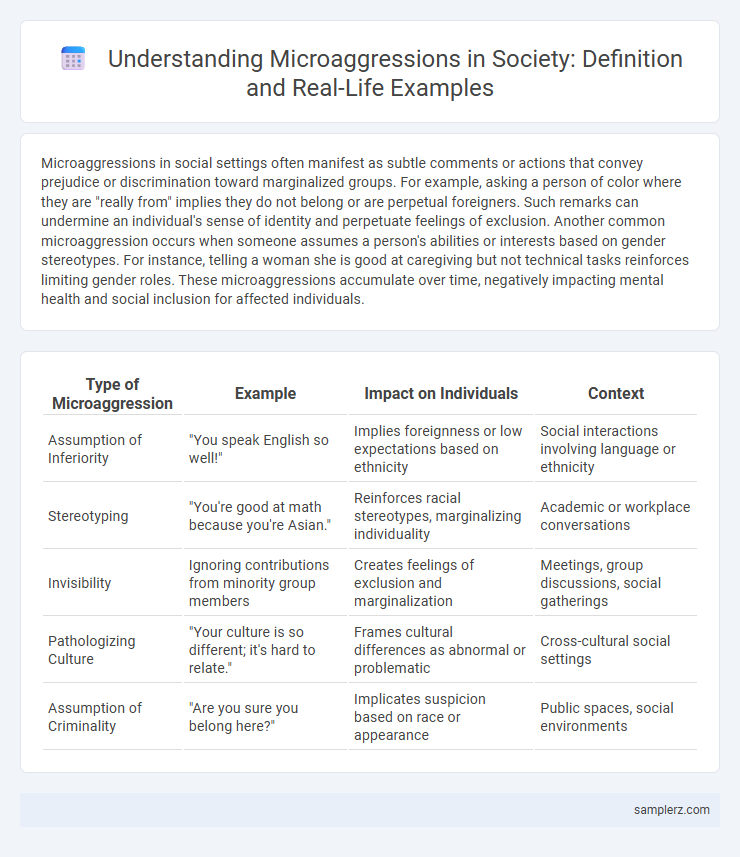Microaggressions in social settings often manifest as subtle comments or actions that convey prejudice or discrimination toward marginalized groups. For example, asking a person of color where they are "really from" implies they do not belong or are perpetual foreigners. Such remarks can undermine an individual's sense of identity and perpetuate feelings of exclusion. Another common microaggression occurs when someone assumes a person's abilities or interests based on gender stereotypes. For instance, telling a woman she is good at caregiving but not technical tasks reinforces limiting gender roles. These microaggressions accumulate over time, negatively impacting mental health and social inclusion for affected individuals.
Table of Comparison
| Type of Microaggression | Example | Impact on Individuals | Context |
|---|---|---|---|
| Assumption of Inferiority | "You speak English so well!" | Implies foreignness or low expectations based on ethnicity | Social interactions involving language or ethnicity |
| Stereotyping | "You're good at math because you're Asian." | Reinforces racial stereotypes, marginalizing individuality | Academic or workplace conversations |
| Invisibility | Ignoring contributions from minority group members | Creates feelings of exclusion and marginalization | Meetings, group discussions, social gatherings |
| Pathologizing Culture | "Your culture is so different; it's hard to relate." | Frames cultural differences as abnormal or problematic | Cross-cultural social settings |
| Assumption of Criminality | "Are you sure you belong here?" | Implicates suspicion based on race or appearance | Public spaces, social environments |
Common Microaggressions in Everyday Conversations
Common microaggressions in everyday conversations often include comments like "You speak English so well," implying surprise based on someone's ethnicity or background. Statements such as "Where are you really from?" subtly question a person's identity and belonging. These remarks, though seemingly innocuous, perpetuate stereotypes and contribute to feelings of exclusion.
Subtle Slights: Unintended Insults in Social Gatherings
Microaggressions in social gatherings often manifest as subtle slights, such as complimenting someone's English proficiency when they are a native speaker, which unintentionally questions their identity. These unintended insults can create discomfort and reinforce feelings of exclusion among marginalized groups. Recognizing phrases like "You're so articulate" or assumptions based on stereotypes helps foster more inclusive social interactions.
Racial Microaggressions at Social Events
Racial microaggressions at social events often manifest as subtle comments or behaviors that demean individuals based on their race, such as making assumptions about someone's background or abilities. Common examples include asking a person of color where they are "really from" or complimenting their English, implying it is unexpected. These seemingly minor interactions contribute to feelings of exclusion and reinforce racial stereotypes in social settings.
Gender-Based Microaggressions in Group Settings
Gender-based microaggressions in group settings often manifest as subtle comments or behaviors that undermine someone's gender identity or contribution, such as interrupting women during meetings or dismissing their ideas. These actions reinforce unequal power dynamics and contribute to an environment where gender biases persist unnoticed. Recognizing phrases like "You're too emotional" or ignoring female perspectives during discussions highlights the pervasive nature of microaggressions in social interactions.
Microaggressions in Online Social Interactions
Microaggressions in online social interactions often manifest through subtle, dismissive comments or tone that invalidate individuals' identities or experiences, such as sarcastic remarks about someone's cultural background or identity. These acts, though seemingly minor, contribute to a hostile digital environment and reinforce systemic biases, particularly in social media platforms and online forums. Understanding the impact of microaggressions in virtual spaces is critical for fostering more inclusive and respectful online communities.
Microaggressions Toward the LGBTQ+ Community in Social Circles
Microaggressions toward the LGBTQ+ community in social circles often manifest as subtle comments questioning the validity of non-heteronormative identities, such as asking, "Who's the man in the relationship?" or assuming heterosexuality by default. These remarks invalidate personal experiences and reinforce heteronormative standards, contributing to feelings of exclusion and marginalization. Frequent exposure to such microaggressions correlates with increased stress and decreased mental well-being among LGBTQ+ individuals.
Age-Related Microaggressions in Casual Conversations
Age-related microaggressions in casual conversations often manifest through subtle comments like "You're so tech-savvy for your age" or assuming older adults are unfamiliar with modern trends. These remarks imply outdated stereotypes about cognitive abilities and interests across different age groups. Recognizing and avoiding such language promotes respectful social interactions and counters ageism.
Cultural Microaggressions at Parties and Reunions
Cultural microaggressions at parties and reunions often manifest through insensitive comments about food, attire, or traditions, such as mocking ethnic dishes or questioning cultural dress choices. These subtle actions reinforce stereotypes and create an unwelcoming atmosphere for marginalized groups. Recognizing and addressing cultural microaggressions promotes inclusivity and respect within social gatherings.
Ableist Microaggressions in Social Activities
Ableist microaggressions in social activities often manifest as exclusionary language or assumptions about physical abilities, such as telling someone with a disability they are "inspirational" solely for everyday tasks. These subtle behaviors reinforce stereotypes and create barriers to full participation in group settings. Recognizing and addressing ableist microaggressions fosters more inclusive and equitable social environments.
Responding to Microaggressions in Social Situations
Responding to microaggressions in social situations involves calmly addressing the comment or behavior by asserting personal boundaries and expressing the impact of the microaggression. Using "I" statements such as "I felt uncomfortable when you said..." helps to create awareness without escalating conflict. Developing empathy through active listening encourages respectful dialogue and promotes inclusive social environments.

example of microaggression in social Infographic
 samplerz.com
samplerz.com